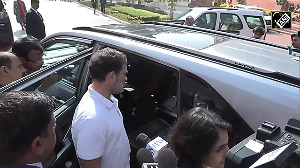What a difference 24 hours can make in the life of a political party.
For the whole two months, Mamata Banerjee's Trinamool Congress has been so critical to the idea of a Congress-led alliance at the Centre, that when it grabbed a lion's share of the seats in West Bengal (28 out of 42, giving the Congress only 14 seats), the Bengal unit of the Congress kept quiet under strict orders from New Delhi.
Moreover, most seats in the South Bengal region, made famous by Nandigram and Singur, had been taken over by the TMC, thereby adding to the party's larger-than-life image.
But with the exit polls on May 13 showing the Left's ability to hold its own in Bengal -- getting between 24-26 seats -- the Mamata Banerjee factor seemed to plunge in value. By the evening of May 13, the Congress seemed to be veering around to the view that if the Left managed to get a total of 30-32 seats, "building bridges with such a large block" was an attractive proposition.
If the polls are off the mark and the Opposition in Bengal is able to get between 20 to 21 seats (of which the Trinamool gets about 14 to 15), then Mamata Banerjee could become one of the more powerful partners of the new Congress-led coalition at the Centre.
However, if the reality reflects the polls on May 16, then the Congress desire to return to power will depend on its ability to forge several contradictory fronts at the same time.
One key front, in West Bengal, will involve keeping a diminished Trinamool Congress inside the government, while the Left Front offers "issue-based support" from outside.
The latter possibility was acknowledged by none other than CPI-M General Secretary Prakash Karat in an interview with the Economic Times on Thursday.
Karat told the newspaper that the Left would not help the Congress party stake claim for power, because it did not approve of its economic, domestic and foreign policies in the last five years, but nor would it stand in its way.
Political observers point out that such an arrangement would be a highly delicate one and prone to constant fracturing, but accepted it could work for a short while -- say, a couple of years until the next election.
Some say the Trinamool, whether it does well or badly, will exact its price for being the only party that has seriously challenged the Left on its own turf in Bengal, for the first time in 32 years.
That is, the TMC will demand that the Congress sack the CPI-M-led government in Bengal, thereby paving the way for its own government in Kolkata.
However, the observers added, if the Left offers the Congress-led coalition outside support, then it may be extremely difficult for the Congress to listen to the TMC and upturn the apple-cart in Bengal.
That is why Mamata is sitting pretty these days, waiting for the results to come in. She has able to create a 'wave of change' against the CPI-M in Bengal, keep the anti-Left sentiment charged due to Nandigram and Singur and provide a real alternative to the Left.
Her comments at a press conference in March when she launched her manifesto, promising to make 'north Bengal Asia's Switzerland and Kolkata another London,' may have evoked some derision, but clearly, Mamata's simple style and her unwavering commitment to the anti-land acquisition cause has built her a significant following.
Mahasweta Devi, the well-known social activist and writer, believes that "not since Mahatma Gandhi have we seen anyone who is so committed to the marginalised people."
All over Kolkata as well as in the southern part of the state, Mamata's courage in taking on the CPI-M's party cadres in the villages, going on a 26-day hunger strike in support of the anti-Singur issue in December 2006 and simply, staying the course against the Left, has struck a deep chord.
Asked if her whimsical nature didn't put them off, Muslim voters in North Kolkata constituency where TMC candidate Sudip Bandopadhyaya is fighting the CPI-M's Mohammed Salim, emphasised that "she had changed considerably." She no longer shouts all the time, now she listens to the workers, they said.
The Left seeks to picture her as untrustworthy, switching sides more than once, joining the BJP-led National Democratic Alliance in 1999 and now being part of the Congress alliance.
But in her defence, Mamata points out that when she was within the NDA, she was able to bring about pro-people policies, including a reduction in the price of petrol.
Mahasweta Devi points out that one of Mamata's greatest strengths is her total lack of hauteur, an attitude several leaders of the Bengal Left are often accused of.
Mamata herself told a press conference in Kolkata a few days ago that she had never travelled by executive class airfare, although she was entitled to do so by Parliament, and had saved the exchequer at least Rs 40 lakh (Rs 4 million).
Her simplicity notwithstanding, Mamata's ability to create a party which has attracted several rebels from the Left parties has been significant. Political observers say the Trinamool Congress has been able to channelise the anger and resentment against the Left over peasantry and farmland issues, and transform it into a political tool.
Her importance, several independent analysts said, "is not a reflection of the public's interest in a pro-Trinamool vision, as much as a reflection of the anger against the CPI-M."





